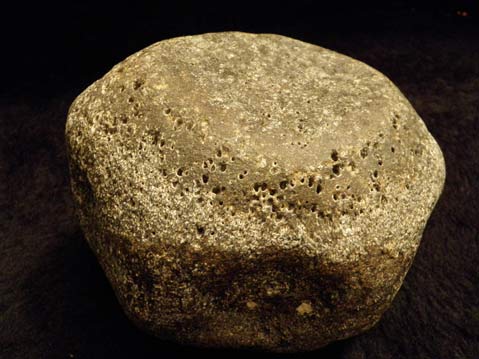Stepping on Petrified Bones
Beach Fossils Widespread in Goleta

I walked into the office of UCSB vertebrate paleontologist Dr. Andy Wyss carrying an ancient whale vertebra. Black but with a porous bone-like structure, it was about the size of a cereal bowl and it was stone. “Ah, yes,” he said, “I thought it might be bigger.”

After learning that the pentagonal backbone was indeed a petrified whale vertebra around 10 million years old, Wyss informed me that it was not diagnostic—he could not tell what kind of whale it came from. “Is it valuable?” I asked. “Not scientifically,” he said.
Back at home it didn’t take long to establish that the online resale value was approximately $40.00—maybe a bit more if it was sliced, polished, and photographed on a piece of black velvet. Incidentally, the cost of fossilized dung is in the same price range.
Wyss maintains that discerning the scientific value of a fossil is an “almost existential” endeavor. If the vestige could reveal a previously unknown species, yield new information about an animal’s range extension, or provide additional data about the ancient climate, it would prove significant.
In line with the somewhat intangible criteria for determining fossil significance, laws around the topic of collecting seem somewhat malleable. While both federal and statewide laws protect paleontological resources, especially from commercial endeavors, picking up a rock for personal keepsake is a grey area and depends in large part on where you are standing. For example, the Omnibus Public Land Management Act of 2009 states that collecting fossils on federal land requires a permit. However, it does allow for casual collecting as defined by “the collecting of a reasonable amount of common invertebrate and plant paleontological resources for non-commercial personal use, either by surface collection or the use of non-powered hand tools resulting in only negligible disturbance to the Earth’s surface and other resources.”
Here in Goleta, beach fossils are widespread. In many places, sand washes away to reveal a rock-like floor during winter months, and swell surges rouse long-ago ocean inhabitants. In fact, since the storms (or maybe since I have started looking) I have noticed many petrified bones scattered among the cobbles and sand. I’d be willing to bet that you beach-goers have stepped on a few yourselves, and surely some of those ancient larger bones have gone unnoticed in your peripheral vision. I’ve heard accounts of rock-embedded fossils at frequented Goleta beaches, though I’ve yet to see them myself. Look down as the tide wanes, or up to the bluffs.
Even if your eye doesn’t fall on the form of a giant animal, the bluff’s striped layers point to a story in which mud, deposited in sheets along our ancient ocean floor, was squeezed and cemented. The result was eventually pushed up as a stacked sequence of rock to reveal a chronicle and our seaside cliffs.
When someone contacts Wyss regarding a fossil find the second question he asks is, “Where did it come from?” Multiple rock layers that span a landscape are called geologic formations. In Goleta several formations exist that can be associated with the geologic time scale. The Monterey Formation, for example, named for the Central California city where it was first described, was deposited under the sea during a period which spans 5 to 30 million years ago (the Miocene epoch). It is largely characterized by its diatomaceous component. Diatoms, single-celled organisms with a glass-like (silica) cell wall, settled, covered, and intercalated ancient surfaces. For petrified bone, dissolved silica permeated into the cavities of the bone, replacing the bone molecule by molecule. In many cases, no bone remains. And while one can argue that this by definition is rock through and through, by virtue of its structure, it is a fossil.
The first question Wyss asks is whether he can see a picture of the find. Many rocks brought in for identification are—rocks. It doesn’t take too much imagination to see a pattern, picture, or body part in the stone shapes of our surroundings. Wyss calls them “unusually shaped nodules of sediment (concretions).” Even with a bona fide fossil, how much morphology of an animal is preserved is key to determining significance. Most finds, like the ones I’ve been stumbling across, are too fragmentary to identify.
As for as the six pound rock-fossil-vertebra that I toted through town, it will spend a small fraction of its existence not underwater or on the sand. For now, interested beachgoers can find it here at the Refugio Education Center.



